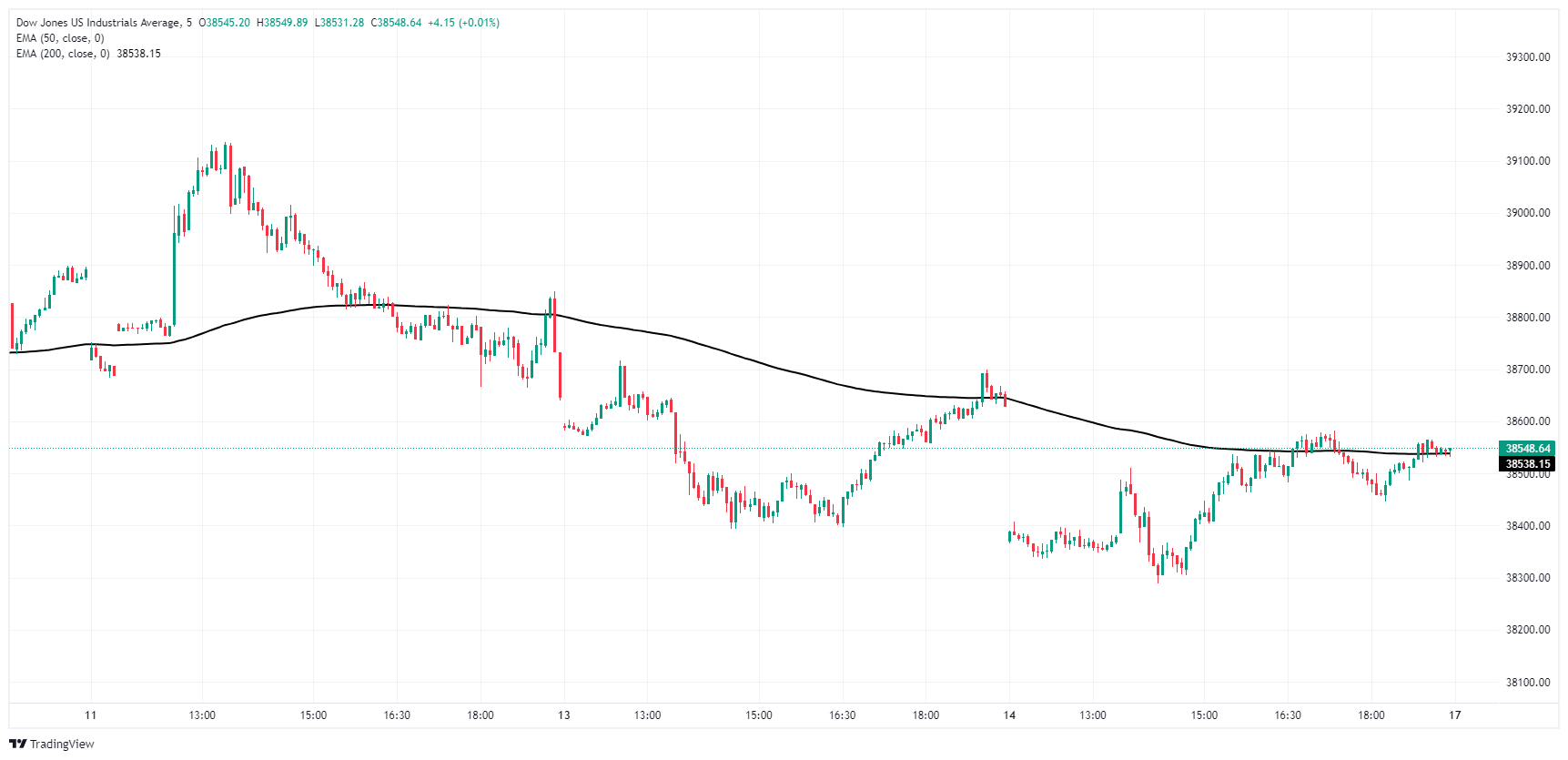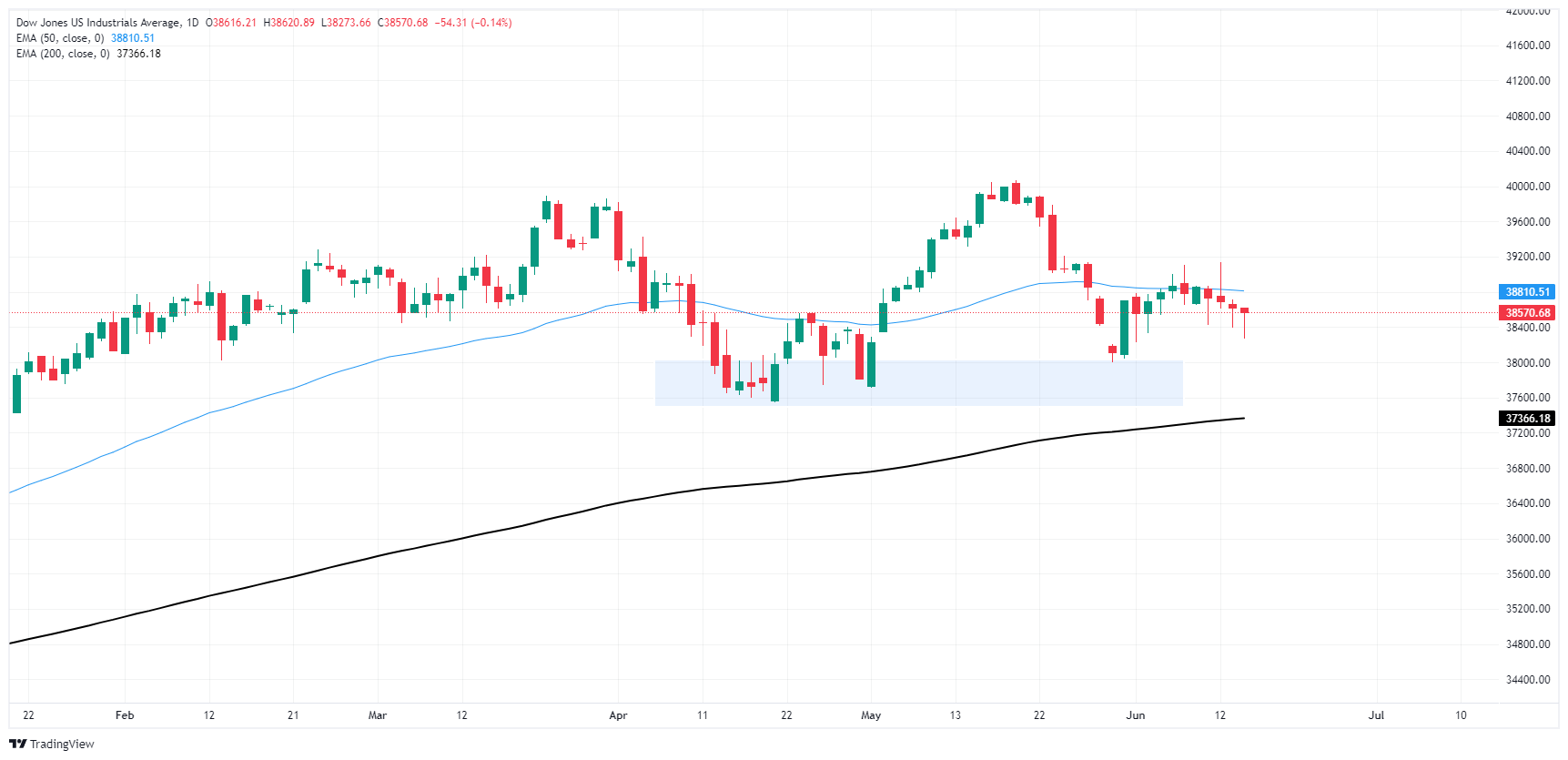- Dow Jones rises intraday, but still on the low side of Thursday’s close.
- UoM”s Consumer Sentiment Index flubs forecasts, declines further.
- Consumer inflation expectations ticked higher in June.
The Dow Jones Industrial Average (DJIA) climbed from an early low on Friday, but sill traded on the low side of Thursday’s closing bids after getting knocked further back during the overnight session. Friday has been a slow grind as markets attempt to recover lost ground, but market confidence remains half-hearted after the University of Michigan’s (UoM) Consumer Sentiment Index declined to a six-month low and missed a forecast recovery, while the UoM’s Consumer Inflation Expectations ticked back into a recent high as spenders continue to remain despondent on future price growth.
The UoM Consumer Sentiment Index survey declined to 65.6 in June, entirely missing the forecast uptick to 72,0 and dropping from the previous 69.1, tumbling to a six-month low as consumers grow increasingly fearful about the state of the US economy. 5-year Consumer Inflation Expectations also ticked back up to a familiar high of 3.1% from the previous 3.0% as price growth continues to weigh on consumers’ economic outlook.
The wind was taken out of market sails this week after the Federal Reserve’s (Fed) latest Summary of Economic Projections (SEP) revealed that market hopes for multiple rate cuts continue to run well ahead of what the Fed expects in the future. The Fed’s “dot plot” of median interest rate expectations shifted lower to only a single rate cut in 2024, down even further from the three projected in March.
Despite the cautious tone from the Fed, rate markets are still pricing in hopes for a September rate cut. According to the CME’s FedWatch Tool, rate traders are pricing in nearly 70% odds of at least a quarter-point rate trim from the Fed at the September 18 rate decision.
Dow Jones news
Two-thirds of the Dow Jones’ constituent securities are in the red on Friday as sentiment tilts lower. Salesforce Inc. (CRM) is recovering from near-term selling pressure, climbing 1.3% to $232.00 per share to lead the scant gainers on the Dow Jones for the day. On the low side, Boeing Co. (BA) has declined -2.06% on Friday, backsliding below $55.00 per share.
Dow Jones technical outlook
Friday’s US session etched in a new weekly low in the Dow Jones, declining to 38,300.00 near the day’s market open before making a meager recovery to chart territory just above 38,500.00. Bullish momentum still has the DJIA trading below Thursday’s closing bids near 38,650.00, but an exhaustion play could easily drag the major equity index back towards the 38,000.00 handle.
The Dow Jones Industrial Average is on pace to close slightly lower for a fourth consecutive day on Friday, and the index has continued waffle down from recent all-time highs above 40,000.00 set in May. The index continues to hold north of the 200-day Exponential Moving Average (EMA) at 37,369.62, and a demand zone is holding in place to catch any short side pushes below the 38,000.00 handle.
Dow Jones five minute chart
Dow Jones daily chart
Dow Jones FAQs
The Dow Jones Industrial Average, one of the oldest stock market indices in the world, is compiled of the 30 most traded stocks in the US. The index is price-weighted rather than weighted by capitalization. It is calculated by summing the prices of the constituent stocks and dividing them by a factor, currently 0.152. The index was founded by Charles Dow, who also founded the Wall Street Journal. In later years it has been criticized for not being broadly representative enough because it only tracks 30 conglomerates, unlike broader indices such as the S&P 500.
Many different factors drive the Dow Jones Industrial Average (DJIA). The aggregate performance of the component companies revealed in quarterly company earnings reports is the main one. US and global macroeconomic data also contributes as it impacts on investor sentiment. The level of interest rates, set by the Federal Reserve (Fed), also influences the DJIA as it affects the cost of credit, on which many corporations are heavily reliant. Therefore, inflation can be a major driver as well as other metrics which impact the Fed decisions.
Dow Theory is a method for identifying the primary trend of the stock market developed by Charles Dow. A key step is to compare the direction of the Dow Jones Industrial Average (DJIA) and the Dow Jones Transportation Average (DJTA) and only follow trends where both are moving in the same direction. Volume is a confirmatory criteria. The theory uses elements of peak and trough analysis. Dow’s theory posits three trend phases: accumulation, when smart money starts buying or selling; public participation, when the wider public joins in; and distribution, when the smart money exits.
There are a number of ways to trade the DJIA. One is to use ETFs which allow investors to trade the DJIA as a single security, rather than having to buy shares in all 30 constituent companies. A leading example is the SPDR Dow Jones Industrial Average ETF (DIA). DJIA futures contracts enable traders to speculate on the future value of the index and Options provide the right, but not the obligation, to buy or sell the index at a predetermined price in the future. Mutual funds enable investors to buy a share of a diversified portfolio of DJIA stocks thus providing exposure to the overall index.
Information on these pages contains forward-looking statements that involve risks and uncertainties. Markets and instruments profiled on this page are for informational purposes only and should not in any way come across as a recommendation to buy or sell in these assets. You should do your own thorough research before making any investment decisions. FXStreet does not in any way guarantee that this information is free from mistakes, errors, or material misstatements. It also does not guarantee that this information is of a timely nature. Investing in Open Markets involves a great deal of risk, including the loss of all or a portion of your investment, as well as emotional distress. All risks, losses and costs associated with investing, including total loss of principal, are your responsibility. The views and opinions expressed in this article are those of the authors and do not necessarily reflect the official policy or position of FXStreet nor its advertisers. The author will not be held responsible for information that is found at the end of links posted on this page.
If not otherwise explicitly mentioned in the body of the article, at the time of writing, the author has no position in any stock mentioned in this article and no business relationship with any company mentioned. The author has not received compensation for writing this article, other than from FXStreet.
FXStreet and the author do not provide personalized recommendations. The author makes no representations as to the accuracy, completeness, or suitability of this information. FXStreet and the author will not be liable for any errors, omissions or any losses, injuries or damages arising from this information and its display or use. Errors and omissions excepted.
The author and FXStreet are not registered investment advisors and nothing in this article is intended to be investment advice.



